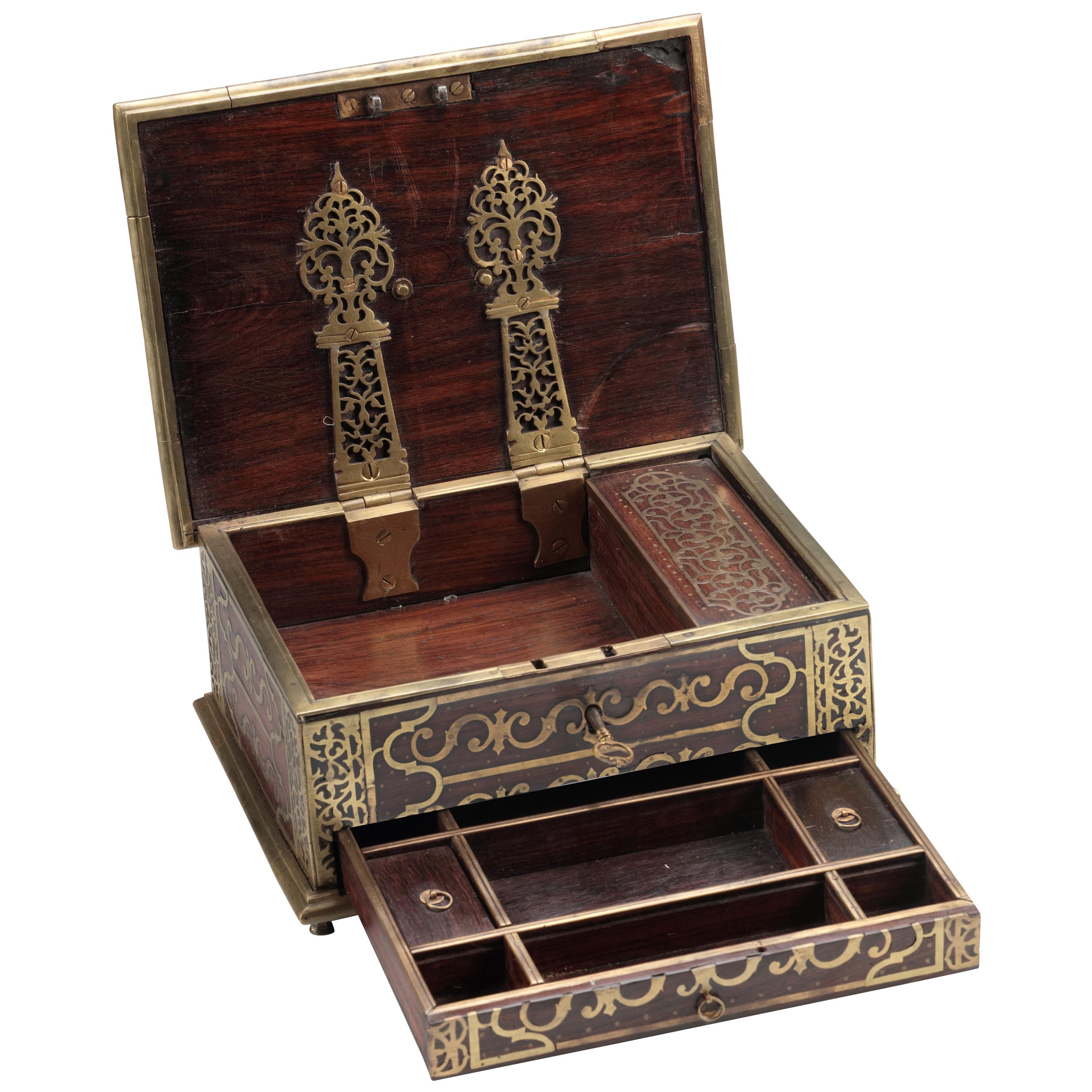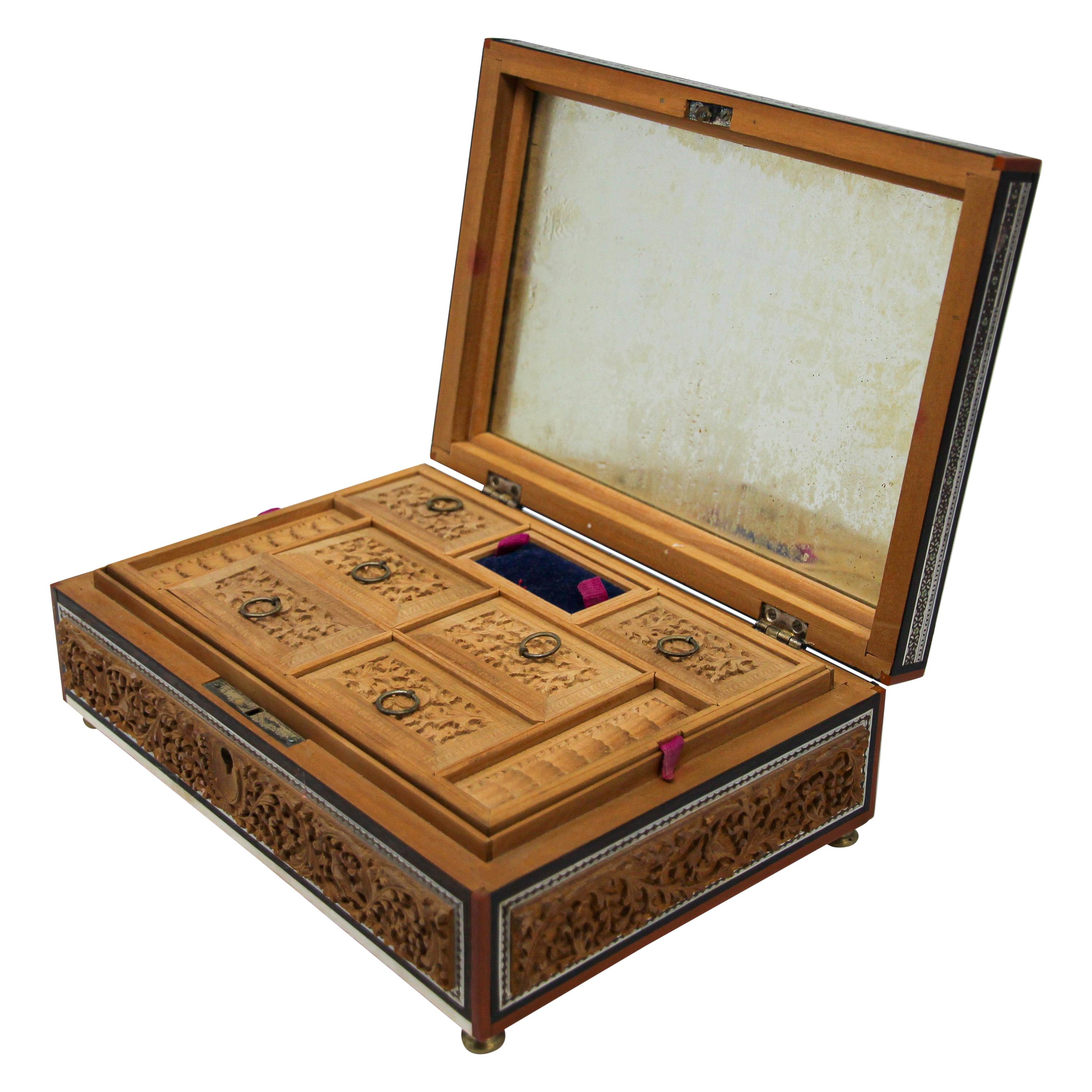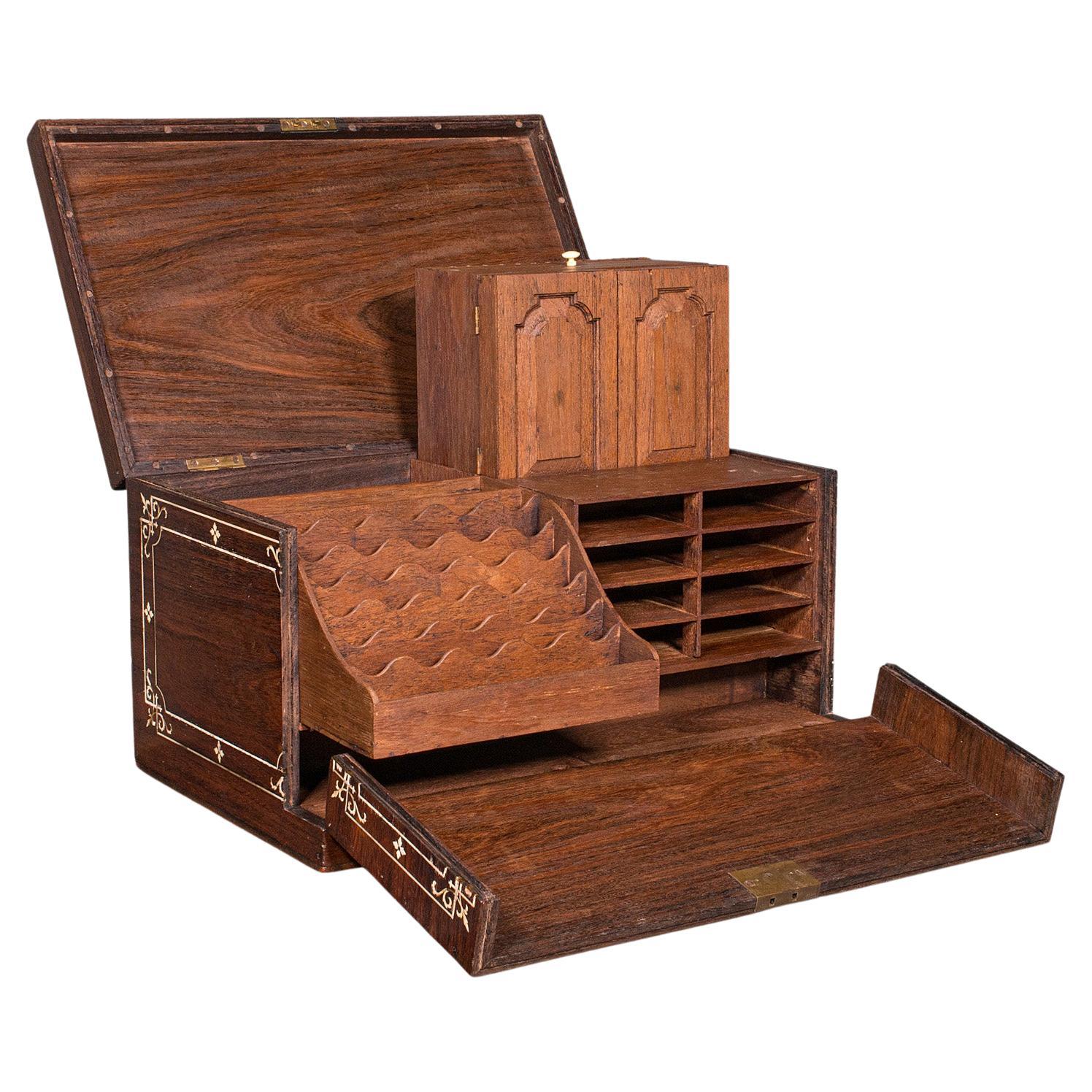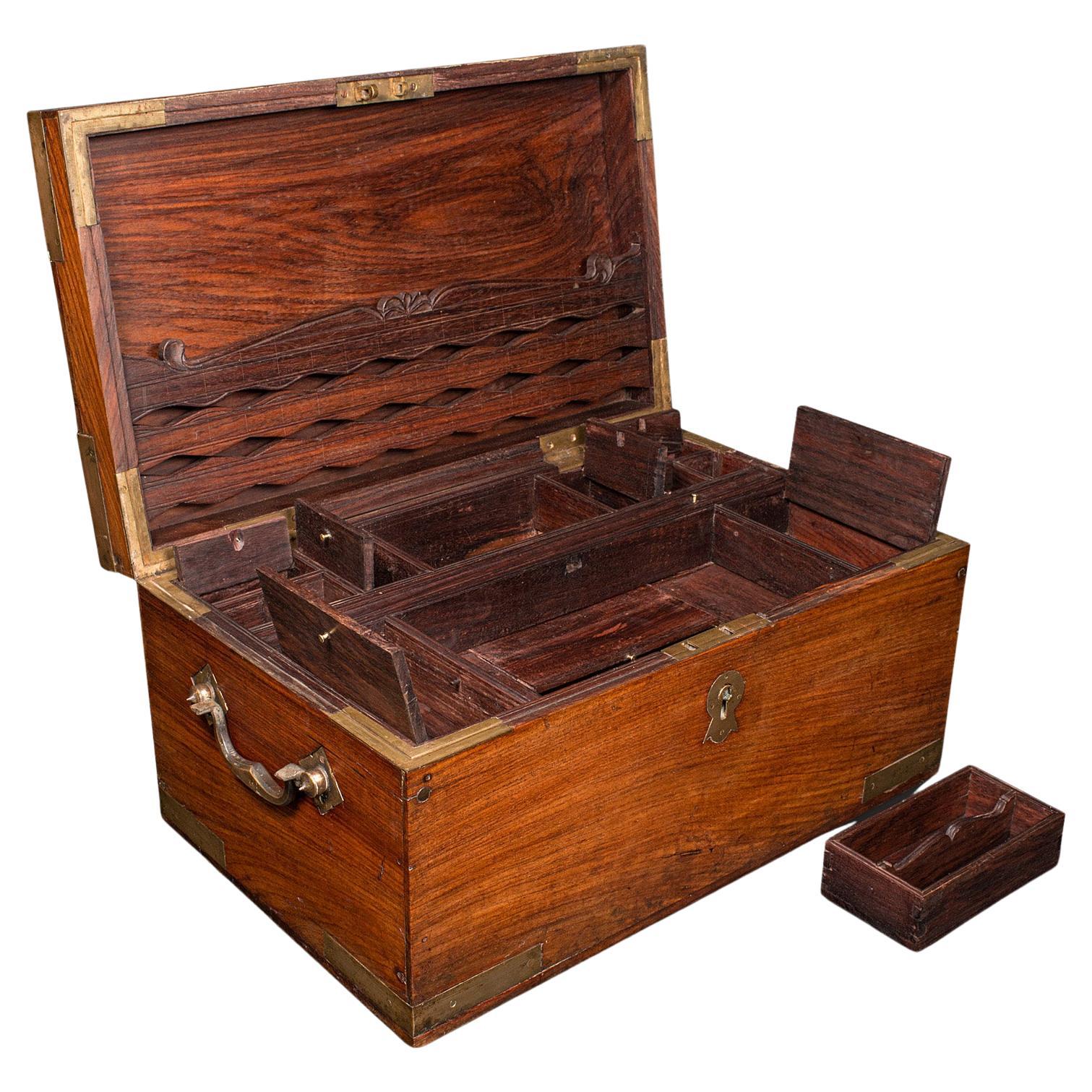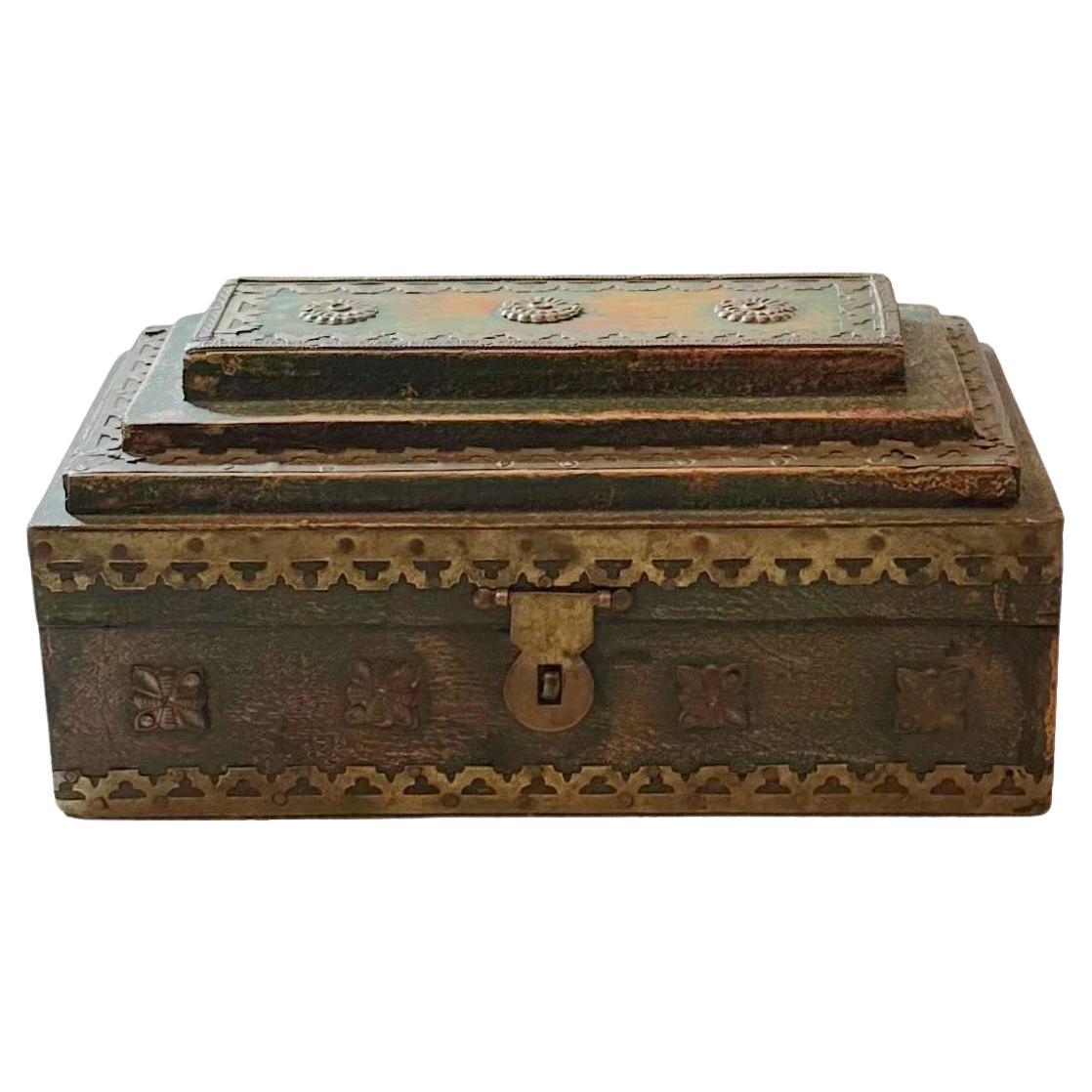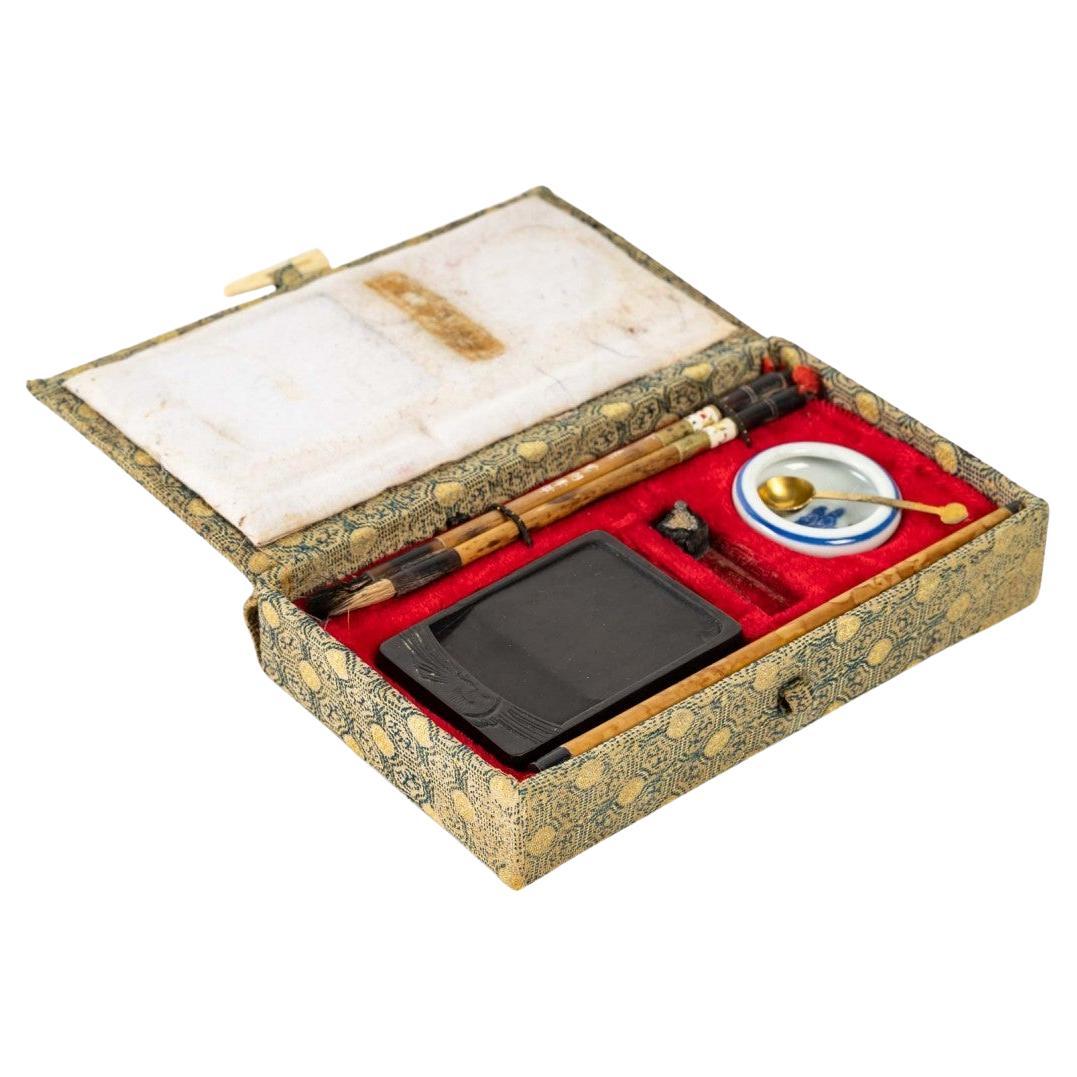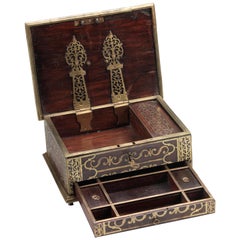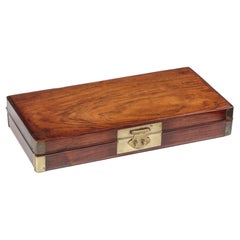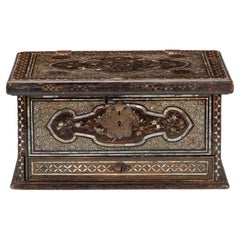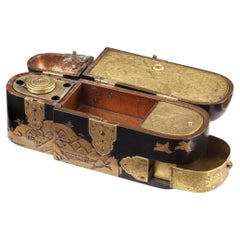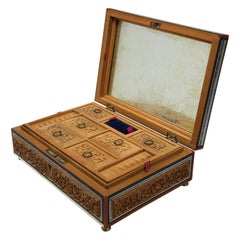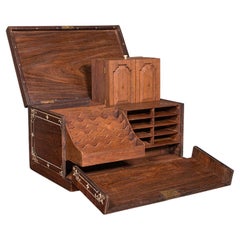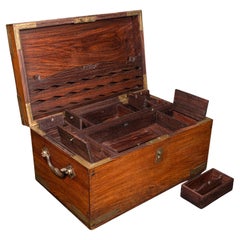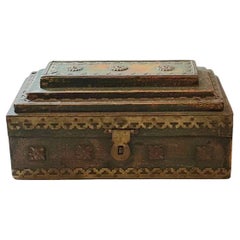Items Similar to Rare Complete Early 19th Century Indian Sadeli Work and Writing Box
Want more images or videos?
Request additional images or videos from the seller
1 of 3
Rare Complete Early 19th Century Indian Sadeli Work and Writing Box
$11,223.80
£8,412.93
€9,500
CA$15,419.59
A$17,214.53
CHF 9,020.15
MX$210,722.68
NOK 114,556.02
SEK 108,011.79
DKK 72,317.47
Shipping
Retrieving quote...The 1stDibs Promise:
Authenticity Guarantee,
Money-Back Guarantee,
24-Hour Cancellation
About the Item
A rare complete Indian Sadeli inlaid work and writing box
British India, Bombay (present-day Mumbai), early 19th century
Micromosaic inlaid wood, with fitted bone interior and tools, and silver fittings.
H. 12.6 x W. 43.2 x D. 28.5 cm
Note:
Workboxes, portable writing desks, inkstands and jewellery boxes were among the variety of 19th century items decorated with geometric micromosaic patterns, called sadeli. Although the generic term “Bombay boxes” is used for a range of boxes decorated in this fashion, production was not limited to Bombay, as Amin Jaffer points out (A. Jaffer, Furniture from British India and Ceylon, London 2001, p. 313). Sadeli boxes were popular souvenirs with travellers to India, as Mrs. Postans observed in the 1830s: “the liberality of homeward-bound friends has now rendered (mosaic work) so much appreciated in England, in the form of presentation workboxes, desks, watch-stands, and numerous other ornamental souvenirs”. Queen Charlotte owned three sadeli boxes “of Bombay work”(Jaffer 2001, p.314).
The sadeli technique came to India from Shiraz in the 16th century. It consists of binding together lengths of geometrically shaped rods of diverse materials such as tin, copper, horn, ivory, sappan wood and ebony arranged in symmetrical geometric patterns. These rods are sliced through transversely and formed into thin sheets of repeating patterns that are laid over and glued to the wooden carcass (see Jaffer 2001, p.313).
- Dimensions:Height: 4.97 in (12.6 cm)Width: 17.01 in (43.2 cm)Depth: 11.23 in (28.5 cm)
- Materials and Techniques:
- Place of Origin:
- Period:
- Date of Manufacture:1800-1810
- Condition:Replacements made: Some internal parts of the sadeli work have been replaced by imitation. Enquire for more photos. Wear consistent with age and use. Minor losses.
- Seller Location:Amsterdam, NL
- Reference Number:1stDibs: LU5458220872482
About the Seller
5.0
Recognized Seller
These prestigious sellers are industry leaders and represent the highest echelon for item quality and design.
Established in 1985
1stDibs seller since 2020
23 sales on 1stDibs
Typical response time: 2 hours
- ShippingRetrieving quote...Shipping from: Amsterdam, Netherlands
- Return Policy
Authenticity Guarantee
In the unlikely event there’s an issue with an item’s authenticity, contact us within 1 year for a full refund. DetailsMoney-Back Guarantee
If your item is not as described, is damaged in transit, or does not arrive, contact us within 7 days for a full refund. Details24-Hour Cancellation
You have a 24-hour grace period in which to reconsider your purchase, with no questions asked.Vetted Professional Sellers
Our world-class sellers must adhere to strict standards for service and quality, maintaining the integrity of our listings.Price-Match Guarantee
If you find that a seller listed the same item for a lower price elsewhere, we’ll match it.Trusted Global Delivery
Our best-in-class carrier network provides specialized shipping options worldwide, including custom delivery.More From This Seller
View AllColonial Islamic Arabian Market Jewelry Box, 18th Century, India/Malabar Coast
Located in Amsterdam, NL
AN INDIAN ROSEWOOD AND EBONY BRASS MOUNTED BOX FOR THE ISLAMIC MARKET
Malabar Coast, 18th century
With a large drawer with several compartm...
Category
Antique 18th Century Indian Islamic Jewelry Boxes
Materials
Brass
Chinese 17th/18th Century Huanghuali Document Box with Baitong Mounts
Located in Amsterdam, NL
A Chinese Huanghuali document box with baitong mounts
Late Ming/Early Qing dynasty, 17th/18th century
H. 6 x W. 34.8 x D. 17.5 cm
Proven...
Category
Antique Late 17th Century Chinese Ming Furniture
Materials
Brass
An exceptional Namban 'escritório' writing-box, with a single drawer
Located in Amsterdam, NL
Kyoto, Late Momoyama to Edo period, circa 1590-1630
Decorated in pearl shell and gold with branches, leaves and flowers inside cartouches on a pearl shell mosaic background.
H. 25 ...
Category
Antique 17th Century Japanese Lacquer
Materials
Gold
Rare 17th Century Japanese Export Lacquer Medical Instrument Box
Located in Amsterdam, NL
A rare Japanese export lacquer medical instrument box
Edo-period, 1650-1700
L. 19 x W. 6 x H. 8.5 cm
This unconventionally shaped lacquer b...
Category
Antique 17th Century Japanese Edo Lacquer
Materials
Gold
A highly refined Dutch-colonial Sri Lankan inlaid box with silver mounts
Located in Amsterdam, NL
Galle district, 18th century
The box is made of amboyna burr with inlays of ebony, bone and burr wood and has several interior compartments, all made with the utmost attention to de...
Category
Antique 18th Century Sri Lankan Decorative Boxes
Materials
Bone, Ebony, Amboyna
16th-Century Indo-Portuguese Colonial Mother-of-pearl Gujarat Casket
Located in Amsterdam, NL
An exceptional Indo-Portuguese colonial mother-of-pearl veneered casket with silver mounts
India, Gujarat, 2nd half of the 16th century, the silver mounts Goa or probably Lisbon
Measures: H. 16 x W. 24.6 x D. 16.1 cm
An exceptional Gujarati casket with a rectangular box and truncated pyramidal lid (with slopes on each side and a flat top) made from exotic wood, probably teak (Tectona grandis), covered with a mother-of-pearl mosaic. The tesserae, cut from the shell of the green turban sea snail (Turbo marmoratus, a marine gastropod) in the shape of fish scales, are pinned to the wooden structure with silver ball-headed nails. The casket is set on bracket feet on the corners. The masterfully engraved decoration of the silver mounts follows the most refined and erudite Mannerist repertoire of rinceaux and ferroneries dating from the mid-16th century. The high quality and refinement of the silver mounts and, likewise, the silver nails that replaced the original brass pins used to hold the mother-of-pearl tesserae in place indicate the work of a silversmith probably working in Lisbon in the second half of the 16th century.
The Indian origin of this production, namely from Cambay (Khambhat) and Surat in the present state of Gujarat in north India, is, as for the last three decades, consensual and fully demonstrated, not only by documentary and literary evidence - such as descriptions, travelogues and contemporary archival documentation - but also by the survival in situ of 16th-century wooden structures covered in mother-of-pearl tesserae. A fine example is a canopy decorating the tomb (dargah) of the Sufi saint, Sheik Salim Chisti (1478-1572) in Fatehpur Sikri in Agra district in the state of Uttar Pradesh, north India. This is an artistic production, geometric in character and Islamic in nature, where usually the mother-of-pearl tesserae form complex designs of fish scales or, similar to the dishes also made using the same technique, with the thin brass sheets and pins, stylized lotus flowers. The truncated pyramidal shape corresponds, like their contemporary tortoiseshell counterparts also made in Gujarat, to a piece of furniture used in the Indian subcontinent within the Islamic world prior to the arrival of the first Portuguese. This shape, in fact, is very old and peculiar to East-Asian caskets, chests or boxes used to contain and protect Buddhist texts, the sutras.
A similar chest is the famous and large reliquary chest from Lisbon cathedral that once contained the relics of the city's patron saint, Saint Vincent. Both match in shape, having the same kind of socle or pedestal and bracket feet, and in their engraved silver mountings, featuring the same type of refined, erudite decoration. Their differences lie in the silver borders that frame the entire length of the edges of the chest (both the box and the lid), pinned with silver nails, and on the lock plate, shaped like a coat of arms in the Lisbon example. Given the exceptional dimensions of the reliquary casket...
Category
Antique 16th Century Indian Jewelry Boxes
Materials
Silver
You May Also Like
Anglo-Indian Footed Box with Lidded Compartments, 19th Century
Located in North Hollywood, CA
19th century Anglo-Indian wooden box fitted with various compartments finely hand carved.
The top is finely hand carved with the Taj Mahal.
The interior with removable hand carved nine-lidded compartments, the front cover has a mirror, the whole exhibiting very fine workmanship.
This fine late Victorian Anglo-Indian box from India is in great condition for it age.
A beautiful example of an Anglo-Indian fine art...
Category
Antique Late 19th Century Indian Anglo-Indian Decorative Boxes
Materials
Sandalwood
Antique Campaign Correspondence Box, Anglo Indian, Colonial, Writing, Victorian
Located in Hele, Devon, GB
This is an antique campaign correspondence box. An Anglo-Indian, teak and bone inlaid colonial writing case with fitted interior, dating to the late...
Category
Antique Late 19th Century British Decorative Boxes
Materials
Teak
Antique Campaign Correspondence Box, Indian, Colonial Writing Case, Victorian
Located in Hele, Devon, GB
This is an antique Campaign correspondence box. An Anglo-Indian, teak and brass bound Colonial traveller's writing case, dating to the late Victorian period, circa 1880.
Captivati...
Category
Antique Late 19th Century Indian Campaign Decorative Boxes
Materials
Brass
19th Century Indian Box
Located in Tampa, FL
This exquisite antique box from 19th century India is a true treasure with its rich patina and traces of green paint. The brass studs add a real touch making it a genuine statement p...
Category
Antique 1880s Indian Decorative Boxes
Materials
Brass
Calligraphy Box, XXth century
Located in Saint-Ouen, FR
Calligraphy Box, XXth century.
Calligraphy box with 2 brushes, dry ink, ink plate and small porcelain container with spoon in the original box.
H: 4 cm, W: 17 cm, D: 10 cm.
Category
20th Century Chinese Napoleon III Scholar's Objects
Materials
Textile
14 inch 19th Century Chinese Lacquer Sewing Box
Located in Brea, CA
Big beautiful lacquered chinese sewing box from the 19th century of the Qing dynasty .it is a 14 inch wide big sewing box , Decorated all-over with...
Category
Antique 19th Century Chinese Qing Lacquer
Materials
Lacquer
More Ways To Browse
British India
Antique Writing Box
Tinned Copper
Antique Items India
Indian Jewelry Box
Antique Watch Stand
Ivory Inlay Furniture
Wood Slice Art
Antique Ivory Box
Ivory Boxes Antique
Antique Tinned Copper
Horn Ivory
Rare Antique Tins
Inlay Wooden Box
Antique Wood Slicer
Bombay Antique
Copper And Silver Inlay
Antique Wood Tool Boxes
